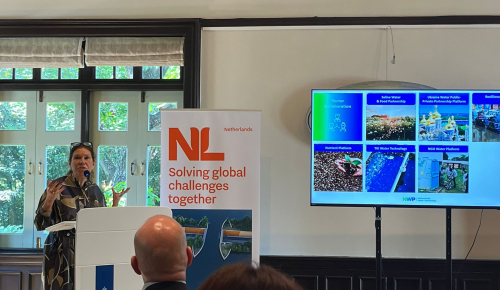News
2 November 2021Preventing and managing wildfires: shifting focus from responsive to predictive

Wildfires are increasing in frequency and intensity due to more frequent extreme heat and drought periods, even in the Netherlands. It is key to protect our forests because they protect our ecosystems through CO2 uptake and providing habitat for wildlife. That is why NWP members Frontier Ventures, eLEAF and HydroLogic joined forces in 2020 to develop an early warning system, based on satellite data and groundwater modelling, to predict the onset and development of wildfires and to translate the information into a plan of action to prevent or control the fires. And that is not all.
Duska Disselhoff, Founder and Managing Director of Frontier Ventures BV: "The urgency of preventing wildfires is crystal clear. Just look at recent events in Greece, Portugal, Spain and France. The increasing drought is the result of climate change and human actions, such as increasing groundwater abstraction due to population growth, economic growth or land-use change. And it is a real risk in the Netherlands as well."
Innovative monitoring
Today, the focus is mainly responsive: how to control a fire after it has already started. Partnership initiator Duska Disselhoff: "We want to shift that focus to predictive, based on data. The more we know about the situation above and below ground, the better we can map the water and energy balance, and the better the insight we obtain. Our data-driven early warning system helps to prevent uncontrolled wildfires and minimise the devastating impact on forests and wildlife."
Frontier Ventures teamed up with eLEAF and HydroLogic. eLEAF is specialised in providing spatial information services based on satellite data. HydroLogic is an international frontrunner in advanced operational hydrological modelling and information services.
Satellite and soil
Joost van der Woerd of eLEAF: "We provide real-time satellite observations of the conditions of the earth's surface. We compute energy balance models to determine what happens with the sun's energy at the Earth's surface, and provide Information related to the evaporation rates of different types of vegetation. The availability of water is an important factor in this. If there is water, it can evaporate. If there is no water, the earth's surface warms up faster."


Maurits Voogt of Hydrologic: "We add the water balance underground. We model how water behaves and moves in an area, what happens to rain and to water in rivers, and what it means for the groundwater level and soil moisture levels in the unsaturated zone. For this we use, among other things, the rain radar, elevation maps, measured water levels and water permeability data. We can use many existing global soil data sets. There are significant differences in detail and reliability, but the quality has increased rapidly in recent decades."
Joost van der Woerd: "Our models are further completed with data on vegetation and land use. Because in addition to drought and temperature, a forest fire needs 'fuel'. The results of past interventions can be included as well, as well as data on infrastructure, buildings and population density. This way, the picture becomes more and more complete which facilitates high-quality decision making. This is also important from an accountability point of view."
Maurits Voogt: "All the elements we bring together are powerful in themselves and have proven their worth. But they are partial solutions and the trick is to bring them together in a holistic approach. By creating this partnership, we have come closer to the solution that is needed. Our added value is that we convert the best data into information, insight and action perspective through data-driven decision making. The insights we want to offer are also operationally valuable. You can't take action everywhere, so it's necessary to focus on the biggest risks."

More than wildfires
And one step further: the approach lays a solid foundation for scenario-based modelling for future developments. Duska Disselhoff: "Of course, it is not just about preventing or controlling wildfires. This approach can also contribute to an investment strategy for forest management, as forests play a large role in natural CO2 uptake and biodiversity conservation. And it provides a landscape management approach to responsibly balance between, for example, housing, economy, and nature."
Launching customer for proof of concept
Duska Disselhoff is convinced that the partnership can provide the necessary insights to deal more effectively with wildfires; a problem that will only become more urgent in the near future.
"We have made contact with a large number of organisations, such as provinces, water authorities, NGOs and safety regions. We are also investigating international options. For example, we have asked NWP if they can help establish contacts with Dutch embassies. Also, we have entered into talks with the World Wildlife Fund to apply our early warning system to better predict wildfires in Bolivia. All these discussions show that the focus is still only responsive and so, a lot still has to be done to shift that focus towards predictive and eventually preventive.
We hope to start the pilot with a launching customer soon, to deliver proof of concept through collecting existing data and adding new data during the monitoring period. It would be great if we could complete the pilot before the next drought season, for it would allow us to immediately apply our insights for reducing the risk of forest fires, increase controllability and limit damage in the pilot area - and beyond."
Get in touch
If you want to know more about this initiative, please contact Duska Disselhoff directly via duska@frontierventures.nl.
Featured NWP members: HydroLogic, eLEAF






